2019: The Year in Review
This year has brought a lot of change, and excitement, to the public safety industry. From the announcement of 911 grant funding for states and tribal nations to advance their efforts to implement next generation 911 (NG911) to an increased, industry-wide focus on cybersecurity and preventing cyberattack, the groundwork has been laid for continued improvement for emergency response in 2020 and beyond.














